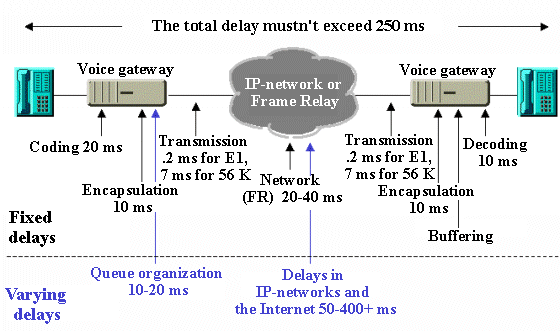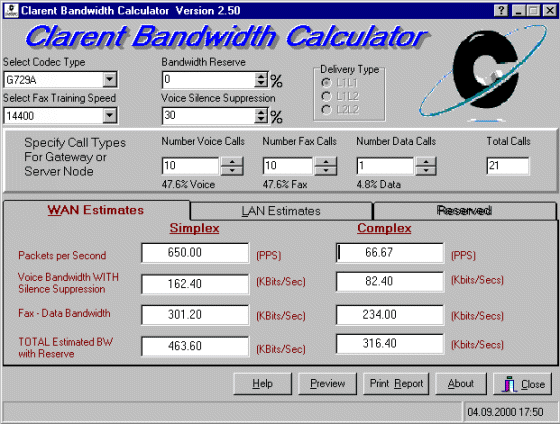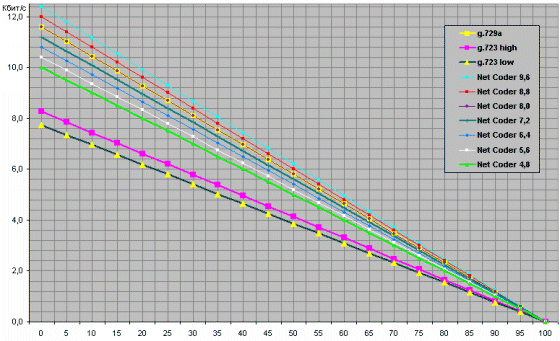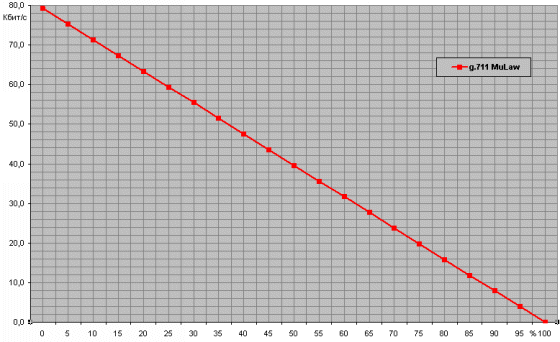 |
||
|
||
| ||
By Igor
Barkov
Delay influence in IP/H.323Networks with commutation of packets were created for data transfer, and the possibility of voice/fax data transfer in real time mode greatly depends on a delay which is brought in with the signal being transferred. Fig.10 demonstrates a scheme of the VoIP network and the delays occurring there.  Fig. 10
Noteworthy is the fact that the delays could cause incorrect functioning of a telephony alarm in the digital paths E1/T1 on the joint of voice gateways with the equipment of the switched networks. It is because of the fact that H.323 recommendations when appeared were intended for multimedia applications which maintained audio and video conference connection via IP networks. This solution allowed to decrease the cost as compared with systems of a traditional telephony with channel commutation. With the development of IP-telephony it became necessary to connect IP-gateways with Telephony Network of Common Use with E1/T1 digital paths. The gateways connect to digital automatic telephone exchange, using standard telephony alarm Q.931. According to Q.931, time delays between phases of accomplishing alarm commands are set to definite values. However, when interpreting Q.931 commands with H.225/TCÐ/IP, the delays occurring increase the set time between Q.931 commands, and can prevent the protocol functioning. Although the version 2 of H.323 includes H.323v2 Fast Connect, the delays can exceed all the admissible intervals of Q.931 protocol. This makes reasonable organizing of clear channels in IP-telephony networks. Clarent Bandwidth CalculatorClarent company has developed a program called Clarent Bandwidth Calculator (fig.11) to simplify calculations of a presumable data rate for gateway-gateway IP-channels when transferring voice/fax data.  Fig. 11
The results (Kbit/s) are calculated for the local network and for WAN interfaces. The source data are: a codec type, the number of simultaneous conversations, the set value of a voice detector threshold, and reserved bandwidth. In Complex part you can see the results calculated with the usage of information optimal compression technology. In Simplex part there are the figures for a usual gateway for IP-telephony under H.323. Below you can see the results made with the help of the Clarent Bandwidth Calculator for a usual IP-gateway with different combinations of parameters. How a WAN channel bandwidth depends on a codec's type and the number of simultaneous conversationsThe calculations were implemented for a 30-channel voice gateway working under the control of H.323 gatekeeper via and E1 PRI digital path. The bandwidth of the WAN channel is completely accessible for a telephony traffic and doesn't have a reserve. The trigger level of a voice detector is 30% of the maximum signal amplitude. The network utilize RAS procedure to define the connection of the gateway and the gatekeeper. Figure 12 demonstrates data rates in the WAN channel depending on the number of simultaneous conversations with the following codecs: G.723.1 Low, G.723.1 High, G.729a, NetCoder. The number of I/O calls increases statically. Keep in mind that the data rate is changing constantly in a multichannel IP-gateway.  Fig. 12
Here we should notice that:
Switching VAD…Fig. 13 illustrates the requirements to the bandwidth of a gateway-gateway channel of H.323 network, depending on a codec's type and a voice detector threshold.  Fig. 13
The presumable data rate in the IP-channel depending on a voice detector threshold value with the usage of G.711 codec are shown in the figure 14.  Fig. 14
Facsimile messages transfer via IPFirst time ITU-T published a protocol of interconnection of analog facsimile sets in 1980. Those fax machines were reckoned in the Group 3. The protocol consists of several parts which reflect the different stages of fax transferring. The messages are transferred with the modulated carrier frequency via a usual telephony network. The speed of document image transfer constitutes 64 Kbit/s. T.30 specification divides the process of fascimile message transfer into 5 stages: A – Dial-up, connection B – Mutual identification of facsimile sets, speed choice C – Transfer of a document image D – Revise of the number of pages E – Connection break According to T.4, a document image is transferred in a file in TIFF-F format through modems. At the end of each block you will see EOL (end of line). At the end of the last block it will be written 6 times. In 1998 in the second version of H.323 the T.38 specification introduces Fax Relay technology intended for fax transfer in real time mode. The practical realization of FoIP is included in all modern IP-gateways of an operator level. However, not all gateways of different manufacturers are compatible when transferring a facsimile traffic. And the realization of T.38 mechanism of different manufacturers turns out the secret information. Some more about Fax Relay T.38 you can find on http://www.vocal.com/data_sheets/t38.html. And as for T.38 Fax Relay realization, CISCO Systems company is of great interest. According to CISCO Systems, after connecting to an IP-gateway and transferring the information on the number of the called abonents (Stage A), the facsimile set tries to connect the called fax machine and to set the parameters of a connection speed (Stage B), and the voice gateways on the both ends detect and transmit standard messages of T.30 to the connected fax machines with the connection speed 2,4-14,4 Kbit/s. So, the stages B and D are not necessary to implement. Note, that the process of a document image transfer makes certain requirements to phase distortions of the signal, delays in the path, and to delays when coding/decoding. That's why the most effective for facsimile signal coding are PCM codecs. The process of document image transfer via the packet network is implemented with the usage of UDP protocol and the following technological methods:
Fig.15 shows the results of data rate calculations in IP-channel for different number of simultaneous calls with usage of T.38 Fax Relay.  Fig. 15
PCM SwitchoverThis is a similar to T.38 Fax Relay technology of the data transfer via IP-gateway with the usage of usual analog modems. When detecting a signal with a carrier frequency of an analog modem at the moment of the phase of data transfer there is created a transparent IP-connection with usage of G.711 codec (64 Kbit/s). With V.90 modem, good connection with a local operator of IP-telephony and PCM Switchover support you can get the connection similar to 64 Kbit/s channel. Conclusion
Besides:
Write a comment below. No registration needed!
|
Platform · Video · Multimedia · Mobile · Other || About us & Privacy policy · Twitter · Facebook Copyright © Byrds Research & Publishing, Ltd., 1997–2011. All rights reserved. |